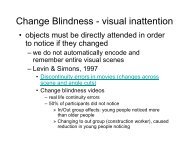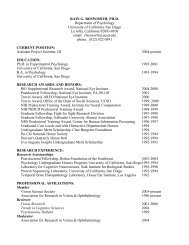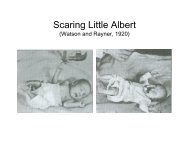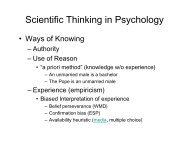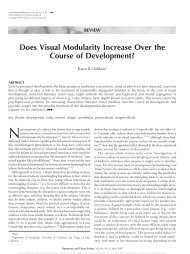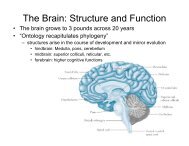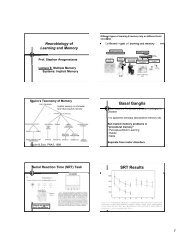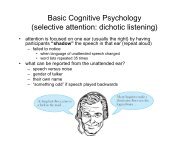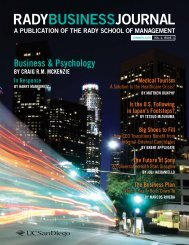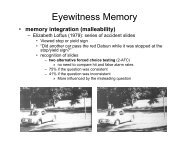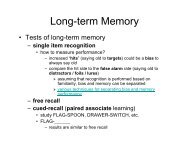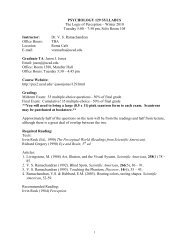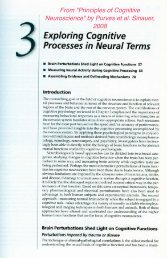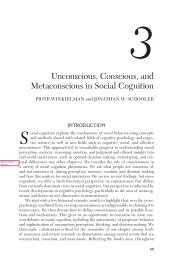Can a machine tickle?
Can a machine tickle?
Can a machine tickle?
Create successful ePaper yourself
Turn your PDF publications into a flip-book with our unique Google optimized e-Paper software.
Psychonomic Bulletin & Review<br />
1999, 6 (3), 504-510<br />
One of the most basic observations about tickling is<br />
that one does not laugh and smile when one tries to <strong>tickle</strong><br />
oneself. The inability to self-<strong>tickle</strong> is compelling evidence<br />
that tickling requires some factor beyond just a particular<br />
sort of physical stimulation of the ribs, feet, or other<br />
body part. However, the precise nature of the additional<br />
factor has been the subject of some debate (Harris, 1999).<br />
On one side is a reflex view, suggesting that what is lacking<br />
in self-<strong>tickle</strong> is unpredictability or uncontrollability.<br />
On the other side of the debate is the interpersonal view,<br />
proponents of which suggest that one cannot <strong>tickle</strong> oneself<br />
because tickling is fundamentally an interpersonal<br />
experience.<br />
The notion that the <strong>tickle</strong> response is a reflex was advocated<br />
by G. Stanley Hall and other writers around the<br />
turn of the century (Hall & Allin, 1897; Sully, 1902). A<br />
writer for the Edinburgh Review (“Art,” 1912) went as far<br />
as to claim that “in the phenomenon of tickling we get<br />
laughter produced as a purely physiological reflex, so unconnected<br />
with mental appreciation” (p. 385). More recently,<br />
Black (1984) noted that laughter “is unique in that<br />
it is both a reflex and a psychosomatic event. . . . For example,<br />
as a reflex, laughter can be elicited by tickling; as<br />
a psychosomatic event, it can be elicited by a circus clown<br />
dropping his pants” (p. 2995). A similar view was suggested<br />
by Francis Bacon (1677), who observed that, when<br />
<strong>tickle</strong>d, “men even in a grieved state of mind, yet cannot<br />
sometimes forbear laughing” (p. 151). Stearns (1972) and<br />
Fridlund and Loftis (1990) have also argued that <strong>tickle</strong><br />
should be considered a reflex.<br />
We gratefully acknowledge Meg Notman’s assistance with the creation<br />
of “Mechanical Meg” and her willingness to <strong>tickle</strong> the feet of<br />
strangers. We also thank Benjamin Liu for providing us with several<br />
references from antiquity. Address requests for reprints to C. R. Harris,<br />
Department of Psychology–0109, University of California, San Diego,<br />
La Jolla, CA 92093-0109 (e-mail: charris@psy.ucsd.edu).<br />
<strong>Can</strong> a <strong>machine</strong> <strong>tickle</strong>?<br />
CHRISTINE R. HARRIS and NICHOLAS CHRISTENFELD<br />
University of California, San Diego, La Jolla, California<br />
It has been observed at least since the time of Aristotle that people cannot <strong>tickle</strong> themselves, but the<br />
reason remains elusive. Two sorts of explanations have been suggested. The interpersonal explanation<br />
suggests that tickling is fundamentally interpersonal and thus requires another person as the<br />
source of the touch. The reflex explanation suggests that <strong>tickle</strong> simply requires an element of unpredictability<br />
or uncontrollability and is more like a reflex or some other stereotyped motor pattern. To<br />
test these explanations, we manipulated the perceived source of tickling. Thirty-five subjects were <strong>tickle</strong>d<br />
twice—once by the experimenter, and once, they believed, by an automated <strong>machine</strong>. The reflex<br />
view predicts that our “<strong>tickle</strong> <strong>machine</strong>” should be as effective as a person in producing laughter,<br />
whereas the interpersonal view predicts significantly attenuated responses. Supporting the reflex view,<br />
subjects smiled, laughed, and wiggled just as often in response to the <strong>machine</strong> as to the experimenter.<br />
Self-reports of ticklishness were also virtually identical in the two conditions. Ticklish laughter evidently<br />
does not require that the stimulation be attributed to another person, as interpersonal accounts imply.<br />
Copyright 1999 Psychonomic Society, Inc. 504<br />
If <strong>tickle</strong> is a reflex (or some other innate stereotyped behavioral<br />
response such as a fixed action pattern), why can<br />
we not elicit it in ourselves? Several possible mechanisms<br />
that are consistent with the reflex notion might be responsible<br />
for inhibiting self-<strong>tickle</strong>. For one, self-<strong>tickle</strong> may be<br />
impossible because the element of surprise is missing.<br />
On this view, <strong>tickle</strong> may be more akin to the startle reflex<br />
than to the knee jerk; one can no more startle oneself than<br />
<strong>tickle</strong> oneself. Another account has been suggested by<br />
Weiskrantz, Elliot, and Darlington (1971), who argue that<br />
to some extent the command, or efferent signal, works to<br />
prevent people from tickling themselves. Thus, what is<br />
sometimes termed exafference (stimulation uncorrelated<br />
with a motor command) may be required in order to elicit<br />
the <strong>tickle</strong> response. While several writers have referred to<br />
the <strong>tickle</strong> response as reflexive, <strong>tickle</strong> may be more complicated<br />
than a standard reflex. It may be more appropriate<br />
to view the behavior as a stereotyped motor pattern that<br />
requires a particular releasing stimulus. Although the<br />
specific mechanisms and terms vary across writers, what<br />
unites this approach to <strong>tickle</strong> is the notion that the inhibition<br />
of self-<strong>tickle</strong> reflects relatively low-level physiological<br />
mechanisms. We will return to these complexities in<br />
the Discussion section.<br />
In contrast, the interpersonal approach to <strong>tickle</strong> assumes<br />
that we cannot <strong>tickle</strong> ourselves because the stimulation<br />
must be known to come from another person, rather than<br />
simply unpredictable or exafferent. For example, Keith-<br />
Spiegel (1972) wrote that “not just anyone or anything<br />
can do the tickling and elicit laughter. It must be administered<br />
by a ‘friendly’ source and done in a playful manner”<br />
(p. 18). Koestler (1964) suggested that laughter will<br />
occur only if the person being <strong>tickle</strong>d views it as a harmless<br />
and playful mock attack. Shultz (1976) aptly points<br />
out an important implication of Koestler’s suggestion:<br />
“The tickling must come from another person; otherwise<br />
it could not be interpreted as an attack” (p. 32). Levine
(1979) describes tickling as “an interaction between two<br />
people in which the relationship is familiar and friendly”<br />
and notes in <strong>tickle</strong> a “dependence upon a second person”<br />
(p. 48). 1 Foot and Chapman (1976) propose that “the social<br />
. . . context in which tickling between two persons<br />
occurs is fundamental to the instigation of laughter”<br />
(p. 189). The interpersonal view also predates modern<br />
psychology: Charles Darwin (1873/1965) argued that the<br />
interpersonal nature of the interaction was critical, and he<br />
speculated that if a stranger tried to <strong>tickle</strong> a child, the child<br />
would scream with fear rather than squeal with laughter.<br />
While opinions about <strong>tickle</strong> are common, empirical observations<br />
are in short supply. One way to distinguish between<br />
the two views of <strong>tickle</strong> is to examine whether manipulations<br />
of the interpersonal context alter the laughter<br />
produced by tickling. Leuba (1941), in a study of two of<br />
his own children, gathered evidence that bears on this<br />
issue. He found that <strong>tickle</strong>-induced laughter emerged despite<br />
his having deliberately refrained from tickling his<br />
children during playful situations and having always hidden<br />
his face behind a mask so that the infants would not<br />
associate tickling with smiles and laughter. Although this<br />
evidence supports the reflexive view, it is far from conclusive.<br />
Leuba did not have a control group, and it is also<br />
possible that the children, even without seeing their father’s<br />
face or hearing him laugh, still viewed his tickling<br />
as well-intentioned and friendly.<br />
In the present investigation, we use a more direct manipulation<br />
to test one key aspect of the interpersonal nature<br />
of <strong>tickle</strong>—namely, that the belief that another person<br />
is doing the tickling is essential in eliciting ticklish laughter.<br />
People were <strong>tickle</strong>d twice; once, they believed, by a<br />
<strong>machine</strong>, and once by a human. According to the reflexive<br />
view, this should make no difference. If the reason why<br />
we cannot <strong>tickle</strong> ourselves is that the stimulation must be<br />
unpredictable or exafferent, the <strong>machine</strong> should be perfectly<br />
capable of tickling. On the other hand, if the reason<br />
we cannot <strong>tickle</strong> ourselves is that <strong>tickle</strong> is necessarily an<br />
interpersonal phenomenon, a <strong>machine</strong> should be considerably<br />
less effective at tickling. Being <strong>tickle</strong>d by a <strong>machine</strong>,<br />
especially if one does not even think that there is another<br />
person in the room, is clearly far less of an interpersonal<br />
situation than is the event of being <strong>tickle</strong>d by a person.<br />
Most writers who have speculated about <strong>tickle</strong> have endorsed<br />
the interpersonal view which predicts that a <strong>machine</strong><br />
should not be an effective <strong>tickle</strong>r. The public also<br />
appears to share this opinion. Of the 48 undergraduates<br />
whom we surveyed, 50% thought that a <strong>tickle</strong> <strong>machine</strong><br />
could not produce laughter, and only 15% thought it could<br />
be as effective as a person who provided the same stimulation.<br />
It should be noted that the sort of <strong>tickle</strong> that results in<br />
laughter may be different from the <strong>tickle</strong> that results in<br />
an “itchy” sensation. The distinction between these sensations<br />
was noted as far back as 1892 in the Dictionary of<br />
Psychological Medicine. The first type of <strong>tickle</strong> is elicited<br />
by a light touch across the skin of almost any part of the<br />
MACHINE TICKLE 505<br />
body. Akin to “a moving itch,” it creates the desire to rub<br />
or scratch the <strong>tickle</strong>d surface. The second type of <strong>tickle</strong>,<br />
usually elicited by a heavier touch to particular areas of<br />
the body such as the armpits or ribs, results in squirming<br />
and laughter. G. Stanley Hall, writing with Arthur Allin<br />
(1897), suggested that the feather-type <strong>tickle</strong> be called<br />
“knismesis” (light <strong>tickle</strong>), and the laughter-inducing<br />
<strong>tickle</strong>, “gargalesis” (heavy <strong>tickle</strong>). One can readily elicit<br />
knismesis in oneself (this is easily demonstrated by dragging<br />
a fingernail lightly over one’s skin). However, one<br />
cannot produce gargalesis in oneself; the present investigation<br />
focuses on this peculiar fact.<br />
METHOD<br />
Subjects<br />
Twenty-one female and 14 male undergraduate students enrolled<br />
in lower division classes at the University of California, San Diego,<br />
participated in exchange for course credit. Their ages ranged from<br />
18 to 28 (M = 19.9, SD = 2.0).<br />
Apparatus and Materials<br />
The <strong>tickle</strong> <strong>machine</strong> was designed to look and sound like a robotic<br />
hand that was capable of movement without the experimenter’s assistance.<br />
The hand was attached by a long flexible hose to an impressive<br />
array of equipment that could plausibly control its motion.<br />
This equipment, when turned on, produced a vibrating sound that<br />
could be that of a genuine robotic apparatus.<br />
Procedure<br />
Subjects reported alone to the “Attention and Perception Laboratory.”<br />
They were told that they would be <strong>tickle</strong>d twice, once by the<br />
experimenter and once by the <strong>machine</strong>. They were instructed to behave<br />
as naturally as possible and were told that they would be asked<br />
to rate the intensity of the <strong>tickle</strong> after each episode. To aid in the deception,<br />
the subjects were asked to wear earplugs and a blindfold,<br />
supposedly to enable them to attend to the <strong>tickle</strong> without distraction.<br />
The subjects were also instructed to keep their eyes shut<br />
throughout the experiment, ostensibly to prevent the blindfold from<br />
irritating their eyes. The blindfold and earplugs were not taken off<br />
until both tickling episodes had been completed. Nonetheless, the<br />
subjects could hear instructions from the experimenter and the<br />
noise from the <strong>machine</strong>. To further aid in the deception, the experimenter<br />
also leaned down and held her hand just in front of the subject’s<br />
foot during the trials in which she was supposedly tickling the<br />
subject. When the experimenter was present during the <strong>machine</strong><br />
<strong>tickle</strong> trials, she rolled her chair away from the subject so that she<br />
would not be within reach of the subject’s foot and so that her voice<br />
would come from a different direction than the <strong>machine</strong>’s noise. For<br />
the trials in which the experimenter left the room, subjects could<br />
hear her leaving and the door closing behind her.<br />
Before donning the earplugs and blindfold, the subject was<br />
seated with the bare right foot dangling off of a footstool that was<br />
placed immediately in front of the <strong>tickle</strong> <strong>machine</strong>’s hand. The subject’s<br />
leg was strapped with Velcro to the footstool. Immediately before<br />
each tickling episode, the subject was told whether the experimenter<br />
or the <strong>machine</strong> would be performing the tickling. The noise<br />
from the <strong>machine</strong> also made this obvious. The order of the alleged<br />
<strong>tickle</strong>r was randomly assigned. In addition, for half of the subjects,<br />
the experimenter left the room during the <strong>machine</strong> <strong>tickle</strong> trial, ostensibly<br />
to watch the experiment through a video monitor in an adjacent<br />
room. Before leaving the room, she pushed one of the buttons<br />
on the <strong>machine</strong> and told the subject that the <strong>machine</strong> tickling<br />
would initiate in approximately 7 sec and that the <strong>machine</strong> would
506 HARRIS AND CHRISTENFELD<br />
Table 1<br />
Mean Ticklishness Ratings as a Function of Tickler<br />
Behavior Self-Report<br />
Condition M SD M SD<br />
Machine 2.79 0.78 4.85 1.34<br />
Experimenter 2.82 0.77 4.82 1.22<br />
Note—The scores for the behavior measure represent means on a 0–4<br />
scale, and self-reports are on a 0–7 Likert-type scale. Higher numbers<br />
indicate greater ticklishness. Each number is based on 33 subjects.<br />
automatically turn itself off after a preprogrammed amount of time.<br />
The <strong>machine</strong> tickling did not begin until the experimenter was out<br />
of the room. Each tickling episode lasted for 5 sec.<br />
In order to be sure that any significant effect of experimental condition<br />
would not be attributable to a difference in the tactile stimulation<br />
itself, neither the <strong>machine</strong> nor the experimenter actually performed<br />
the tickling. Instead, the tickling was performed by a hidden<br />
research assistant. Before the subject entered the <strong>tickle</strong> room, the<br />
research assistant hid under a large table, which was covered with<br />
a floor-length black table cloth. Other tables in this room also were<br />
covered with cloths of varying lengths to minimize suspicion regarding<br />
the use of the table cloth. To perform the tickling, the research<br />
assistant lifted the table cloth a few inches and reached out<br />
to the subject’s foot. To ensure that the <strong>machine</strong> noise and the tickling<br />
started simultaneously, the research assistant controlled a<br />
switch which powered the <strong>machine</strong>’s sound. 2<br />
At the end of the experimental session, the subject was carefully<br />
questioned regarding any suspicions and knowledge about the experiment.<br />
Only 1 subject expressed skepticism about the <strong>tickle</strong> <strong>machine</strong>.<br />
Another subject thought that the <strong>machine</strong> had <strong>tickle</strong>d her<br />
both times. The data from these 2 subjects were not included in the<br />
analyses.<br />
Dependent Measures<br />
Two measures of ticklishness were obtained. Immediately after<br />
each tickling episode, the subject orally rated the <strong>tickle</strong> sensation<br />
using a Likert-type scale of 0 (not at all ticklish) to 7 (extremely<br />
ticklish). Behavioral measures of <strong>tickle</strong> were coded from videotape,<br />
on a five-point scale. Two independent coders scored each <strong>tickle</strong><br />
episode, with 0 = no apparent response; 1 = voiceless smiling; 2 =<br />
laughter; 3 = twisting or wiggling in response to the <strong>tickle</strong>; and 4 =<br />
subject pulls limb away from <strong>tickle</strong>r thereby stopping the tickling<br />
before the allotted 5 sec. This response intensity scale has been used<br />
previously and has been shown to correlate highly with duration<br />
measures (Harris & Christenfeld, 1997).<br />
RESULTS<br />
It is critical that subjects actually believed that the <strong>machine</strong><br />
was performing the tickling. The evidence for this<br />
comes from two sources. At the end of the experimental<br />
session, the subjects filled out a questionnaire describing<br />
differences, if any, between the sensation produced by the<br />
<strong>machine</strong> and by the experimenter. The responses clearly<br />
show that the subjects did indeed believe that the <strong>machine</strong><br />
had <strong>tickle</strong>d them. All of the comments from the 35<br />
subjects who answered this question are provided in the<br />
Appendix. Following the experiment, the subjects were<br />
given a partial debriefing but were not told of the deception.<br />
Instead, they were told that we were only describing<br />
part of our hypothesis and that a full write-up of the experiment<br />
would be available at a later time. The experi-<br />
menter telephoned 9 randomly chosen subjects after the<br />
study was completed. They were asked about what they<br />
had done in the experiment and whether they had any<br />
suspicions about any aspect of the experiment. Despite<br />
repeated questioning about suspicions, they stated confidently<br />
that a <strong>machine</strong> had <strong>tickle</strong>d them. Not one of the subjects<br />
who was called suspected that the <strong>tickle</strong> <strong>machine</strong><br />
was not real.<br />
The reliability of the behavioral responses to the tickling<br />
was assessed by comparing the scores given by two<br />
independent coders. The correlation of ticklishness scores<br />
from the two raters averaged across the <strong>machine</strong>-<strong>tickle</strong> and<br />
experimenter-<strong>tickle</strong> conditions was r(31) = .73, p .0001,<br />
yielding a median Spearman–Brown estimated reliability<br />
of .84 for the two-coder composite. Again averaged across<br />
the two experimental conditions, the self-report and behavioral<br />
dependent variables were significantly associated<br />
with each other [r(31) = .34, p .05].<br />
Because there was no direct or interactive effect of<br />
gender on any dependent variable, we collapsed across<br />
this dimension for all analyses. To determine whether the<br />
belief that a <strong>machine</strong> was performing the tickling would<br />
eliminate <strong>tickle</strong> responses, we performed two separate<br />
paired t tests. The means for behavior and self-reports in<br />
the two conditions are presented in Table 1. There was no<br />
hint of any difference between <strong>tickle</strong> responses produced<br />
by the experimenter and by the <strong>machine</strong> for behavior<br />
[t(32) = 0.27, n.s.] or self-report [t(32) = 0.12, n.s.]. During<br />
the <strong>machine</strong>-<strong>tickle</strong> episode, two unpaired t tests revealed<br />
no difference in <strong>tickle</strong> responses when the experimenter<br />
was in the room and when the subject believed<br />
he/she was alone, for behavior [t(31) = 1.65, n.s.] and<br />
for self-report [t(31) = 0.15, n.s.]. This lack of differences<br />
was not due to a floor effect, because all subjects<br />
in all conditions showed at least some behavioral reaction<br />
to <strong>tickle</strong>: Every subject at least smiled or laughed,<br />
and many also wiggled and pulled their foot away; selfreport<br />
ratings were never lower than 2 on the scale of<br />
0–7. Our analyses suggest that the belief that a <strong>machine</strong> or<br />
a person is performing the tickling has no effect on how<br />
much subjects laugh and smile when <strong>tickle</strong>d or on subjects’<br />
self-reports of <strong>tickle</strong> intensity.<br />
DISCUSSION<br />
The subjects readily smiled, laughed, and wiggled<br />
when <strong>tickle</strong>d by what they believed to be a fully automated<br />
mechanical device. These responses were no different<br />
from responses to a human <strong>tickle</strong>r and also were not altered<br />
when the subjects believed themselves to be entirely<br />
alone in the room with the <strong>tickle</strong> <strong>machine</strong>. These findings<br />
dispute the basic claim of the interpersonal view of<br />
<strong>tickle</strong>—namely, that the inability to <strong>tickle</strong> oneself reflects<br />
the requirement that one believe that another person is<br />
responsible for the tickling. Instead, the results are more<br />
consistent with the view that the inability to <strong>tickle</strong> oneself<br />
is due to inhibition at some lower physiological level; the<br />
<strong>tickle</strong>-<strong>machine</strong> works, because it, like another human
eing but unlike oneself, can produce stimulation that is<br />
unpredictable and/or not canceled by command or afferent<br />
signals.<br />
One might argue that the interpersonal context was not<br />
absolutely eliminated in the present work: The person<br />
being <strong>tickle</strong>d was being watched during the <strong>machine</strong><br />
<strong>tickle</strong> episode, and the <strong>tickle</strong> <strong>machine</strong> is a human construction.<br />
However, if merely knowing that someone was<br />
observing via a video camera were enough to account for<br />
the efficacy of the <strong>machine</strong>, it ought to be possible to self<strong>tickle</strong><br />
when one is observed by another person. It can be<br />
easily demonstrated that this is not so. Thus it is not possible<br />
to defend the interpersonal interpretation in this way.<br />
Similarly, even if the <strong>tickle</strong> <strong>machine</strong> was viewed as a product<br />
of human construction, it must represent a severely<br />
impoverished interpersonal context in comparison with<br />
being <strong>tickle</strong>d by an actual person. We may, in a fit of<br />
pique, kick a malfunctioning soda <strong>machine</strong>, but we do not<br />
experience the thoughts and feelings elicited when another<br />
person deliberately cheats us; no sane individual<br />
would, for example, plot vengeance against the Coke <strong>machine</strong>.<br />
Although it may not be possible to entirely eliminate<br />
the social aspects of a situation, it is possible to reduce<br />
them dramatically. We did this, and it made no<br />
difference in <strong>tickle</strong> responses.<br />
Even if beliefs about the source of the stimulation are<br />
completely irrelevant, <strong>tickle</strong> might still have evolved to<br />
serve functions that arise mostly in interpersonal contexts<br />
(see Provine, 1997, for interesting suggestions along<br />
these lines). Although our data argue against the most extreme<br />
version of an interpersonal view, a looser interpretation<br />
of “social context” would still be consistent with<br />
the present investigation. For example, Provine argues<br />
that any “nonself ” entity could be considered social. Unlike<br />
the more extreme interpersonal claims regarding<br />
<strong>tickle</strong>, this version of “social” is not inconsistent with the<br />
notion that the <strong>tickle</strong> response is reflexive. The results reported<br />
here do not show that the interpersonal context is<br />
irrelevant, only that it is not essential.<br />
The present results are generally favorable to the view<br />
that the <strong>tickle</strong> response is some form of innate stereotyped<br />
motor behavior, perhaps akin to a reflex. The findings<br />
do not reveal precisely what does control the response.<br />
Stearns (1972), writing on the physiology of<br />
laughter, has argued that <strong>tickle</strong> is a reflex and has suggested<br />
a specific potential reflex arc. Realizing that some<br />
might question the use of the term reflex arc for the uncharted<br />
and undoubtedly cortical pathways involved in the<br />
<strong>tickle</strong> response, Stearns writes:<br />
use of this term, involving complex pathways in the brain,<br />
exceeds the [bounds] of Ramon y Cajal’s two neuron reflex<br />
arcs or even those of segmental multineuron reflex arcs. It<br />
corresponds more to what Globus has called suprasegmental<br />
reflex circuits. As Houssay has emphasized: “a<br />
simple isolated reflex is a theoretical abstraction,” and<br />
“the central nervous system normally functions as an integrated<br />
unit . . . . Integration of nervous activity is carried<br />
out at different levels of increasing complexity.” (p. 57)<br />
MACHINE TICKLE 507<br />
Stearns acknowledges that <strong>tickle</strong>-related behaviors can<br />
sometimes be voluntarily inhibited, and suggests this<br />
might be due to the afferent and efferent connections between<br />
the thalamus and frontal cortex. However, he notes<br />
that other reflexes such as the knee jerk or Achilles tendon<br />
reflex can also be inhibited.<br />
Although the term reflex has often been favored by<br />
physicians writing on <strong>tickle</strong>, psychologists have tended to<br />
shy away from this term. There is controversy about the<br />
boundaries between reflexes and other innate speciestypical<br />
behavioral dispositions (Shepherd, 1994). In the<br />
ethological literature, the terms fixed action pattern (or<br />
sometimes modal action pattern; see Barlow, 1996, for<br />
discussion) are often used to describe such innate dispositions.<br />
3 Reflexes are distinguished from fixed action patterns<br />
on the basis of their graded character: The more intense<br />
the stimulation, the more intense the response.<br />
McKimmin (1989) has reported that a high-intensity<br />
<strong>tickle</strong> stimulus produced greater self-reported <strong>tickle</strong> responses<br />
than did a low-intensity stimulus. However, it is<br />
not clear whether ticklish laughter shows a graded response<br />
to the magnitude of stimulation like that which<br />
occurs with the typical reflex, or an all-or-none character<br />
like that of a fixed action pattern. This could be a fruitful<br />
area for future research. If the concept of a fixed action<br />
pattern is appropriate for ticklish laughter, the present results<br />
seem to indicate that the releasing stimulus does not<br />
have to be another person. Further exploration of the parameters<br />
necessary for eliciting ticklish laughter would<br />
be interesting. 4 Our guess is that less is required in order<br />
to elicit ticklish laughter than one might have suspected.<br />
Despite two thousand years of speculation on <strong>tickle</strong><br />
(since Aristotle; see Cooper, 1922), the paucity of actual<br />
research makes it difficult to draw unequivocal conclusions<br />
about this enigmatic aspect of human behavior.<br />
However, there are a few earlier empirical findings that,<br />
like the results reported here, are generally counterintuitive<br />
and broadly consistent with a reflexive interpretation<br />
of <strong>tickle</strong>. One is the finding of Newman, O’Grady, Ryan,<br />
and Hemmes (1993) that when a neutral verbal stimulus<br />
is paired with tickling, the stimulus comes to elicit laughter<br />
and smiling on its own. Another is the finding that<br />
when subjects perceive that they have control over stopping<br />
the tickling, their reports of <strong>tickle</strong> intensity are not<br />
decreased (McKimmin, 1989). Still another is the observation<br />
that medical doctors can inadvertently produce<br />
ticklish laughter in children during physical exams (Freedman,<br />
1989). Although the exam is an interpersonal situation,<br />
it is hard to imagine that children view this situation<br />
as “a mock attack.”<br />
The argument that <strong>tickle</strong> is a reflex, or some other kind<br />
of innate stereotyped motor pattern, does not imply that<br />
the <strong>tickle</strong> response is unaffected by mood or other psychological<br />
states. For example, negative emotional states<br />
have been found to potentiate the startle reflex, whereas<br />
positive emotional states have the opposite effect (Bradley,<br />
Lang, & Cuthbert, 1993). Similarly, some psychological<br />
states might facilitate or reduce laughter in response to
508 HARRIS AND CHRISTENFELD<br />
tickling. We have previously shown that exposing people<br />
to humorous stimuli does not increase ticklish laughter,<br />
and, similarly, tickling people first does not make them<br />
laugh more at humorous stimuli (Harris & Christenfeld,<br />
1997). This suggests that mirth does not heighten responses<br />
to tickling and generally supports the separation<br />
of humorous interpersonal reactions and ticklish laughter<br />
advocated here. However, it is possible that other mood<br />
states might affect <strong>tickle</strong>. For example, DeSanto, Newman,<br />
and Hemmes (1997) found that nervousness interacts<br />
with habituation to <strong>tickle</strong> as does perception of pleasantness<br />
of <strong>tickle</strong>. Provine (1997) also suggests that <strong>tickle</strong><br />
tends to prime itself, with the response rising in intensity<br />
over the course of a tickling session, often until it becomes<br />
too intense to be enjoyable.<br />
In the present study, we found no differences in ticklishness<br />
of male and female subjects, whether they believed<br />
they were being <strong>tickle</strong>d by a woman or by a <strong>machine</strong>.<br />
Previous research has also failed to find evidence<br />
of gender differences in <strong>tickle</strong> responses (Claxton, 1975;<br />
Harris & Christenfeld, 1997). Naturally, this does not<br />
imply that gender differences could not arise in other<br />
contexts. Under some circumstances, it seems, <strong>tickle</strong> can<br />
have erotic overtones for some people. Possible gender<br />
differences in <strong>tickle</strong> would seem an interesting topic for<br />
further investigation, especially since strong gender effects<br />
have been found in conversational laughter (Provine,<br />
1993).<br />
In summary, much remains to be explored about the role<br />
of social and emotional factors in ticklishness. However,<br />
the responses to our <strong>tickle</strong> <strong>machine</strong> strongly suggest that<br />
ticklish laughter itself does not require any belief that another<br />
human being is producing the stimulation.<br />
REFERENCES<br />
Bacon, F. (1677). Sylva sylvarum: or A natural history. London: S. G.<br />
& B. Griffin.<br />
Barlow, G. W. (1996). Ethological units of behavior. In L. Houck &<br />
L. Drickamer (Eds.), Foundations of animal behavior: Classic papers<br />
with commentaries (pp. 138-153). Chicago: University of Chicago<br />
Press.<br />
Black, D. W. (1984). Laughter. Journal of the American Medical Association,<br />
252, 2995-2998.<br />
Bradley, M. M., Lang, P. J., & Cuthbert, B. N. (1993). Emotion,<br />
novelty, and the startle reflex: Habituation in humans. Behavioral<br />
Neuroscience, 107, 970-980.<br />
Claxton, G. (1975). Why can’t we <strong>tickle</strong> ourselves? Perceptual &<br />
Motor Skills, 41, 335-338.<br />
Cooper, L. (Trans.) (1922). An Aristotelian theory of comedy with an<br />
adaptation of the poetics and a translation of the Tractatus coislinianus.<br />
New York: Harcourt, Brace.<br />
Darwin, C. (1965). The expressions of the emotions in man and animals.<br />
Chicago: University of Chicago Press. (Original work published<br />
1873)<br />
DeSanto, V. R., Newman, B., & Hemmes, N. S. (1997). The effects of<br />
perceived aversiveness on habituation to stimulus in human subjects.<br />
Poster presented at the 23rd annual meeting of the Association for<br />
Behavior Analysis, Chicago.<br />
Foot, H. C., & Chapman, A. J. (1976). The social responsiveness of<br />
young children in humorous situations. In A. J. Chapman & H. C.<br />
Foot (Eds.), Humour and laughter: Theory, research, and applications<br />
(pp. 187-214). London: Wiley.<br />
Freedman, B. J. (1989). Now it <strong>tickle</strong>s; now it doesn’t: Psychogenic<br />
variations in the perception of tactile stimuli. British Medical Journal,<br />
299, 250.<br />
Fridlund, A. J., & Loftis, J. M. (1990). Relations between tickling and<br />
humorous laugher: Preliminary support for the Darwin–Hecker hypothesis.<br />
Biological Psychology, 30, 141-150.<br />
Hall, G. S., & Allin, A. (1897). The psychology of tickling, laughing,<br />
and the comic. American Journal of Psychology, 9, 1-44.<br />
Harris, C. R. (1999). The mystery of ticklish laughter. American Scientist,<br />
87, 344-351.<br />
Harris, C. R., & Christenfeld, N. (1997). Humour, <strong>tickle</strong>, and the<br />
Darwin–Hecker hypothesis. Cognition & Emotion, 11, 103-110.<br />
Keith-Spiegel, P. (1972). Early conceptions of humor: Varieties and issues.<br />
In J. H. Goldstein & P. E. McGhee (Eds.), The psychology of<br />
humor (pp. 4-39). New York: Academic Press.<br />
Koestler, A. (1964). The act of creation. London: Hutchinson.<br />
Laughter. (1912). Edinburgh Review, 215, 383-404.<br />
Levine, J. (1979). Humor and psychopathology. In C. Izard (Ed.), Emotions<br />
in personality and psychopathology (pp. 37-69). New York:<br />
Plenum.<br />
Leuba, C. (1941). Tickling and laughter: Two genetic studies. Journal<br />
of Genetic Psychology, 58, 201-209.<br />
McKimmin, P. J. (1989). Tickle sensation, pleasure, anxiety and the role<br />
of perceived control. Unpublished doctoral dissertation, California<br />
School of Professional Psychology, San Diego.<br />
Newman, B., O’Grady, M. A., Ryan, C. S., & Hemmes, N. S. (1993).<br />
Pavlovian conditioning of the <strong>tickle</strong> response of human subjects:<br />
Temporal and delay conditioning. Perceptual & Motor Skills, 77,<br />
779-785.<br />
Provine, R. R. (1993). Laughter punctuates speech: Linguistic, social,<br />
and gender contexts of laugher. Ethology, 95, 291-298.<br />
Provine, R. R. (1996). Laughter. American Scientist, 84, 38-45.<br />
Provine, R. R. (1997). Yawns, laughs, smiles, <strong>tickle</strong>s, and talking: Naturalistic<br />
and laboratory studies of facial action and social communication.<br />
In J. A. Russell & J. M Fernandez-Dols (Eds.), The psychology<br />
of facial expression (pp. 158-175). Cambridge: Cambridge University<br />
Press.<br />
Shepherd, G. M. (1994). Neurobiology (3rd ed.). Oxford: Oxford University<br />
Press.<br />
Shultz, T. R. (1976). A cognitive-developmental analysis of humour.<br />
In A. J. Chapman & H. C. Foot (Eds.), Humour and laughter: Theory,<br />
research, and applications (pp. 12-36). London: Wiley.<br />
Stearns, F. R. (1972). Laughing. Springfield, IL: C. C. Thomas.<br />
Sully, J. (1902). An essay on laughter. New York: Longmans, Green.<br />
Weiskrantz, L., Elliot, J., & Darlington, C. (1971). Preliminary<br />
observations on tickling oneself. Nature, 230, 598-599.<br />
NOTES<br />
1. Levine also raises the possibility that <strong>tickle</strong> is a reflex but notes the<br />
inability to <strong>tickle</strong> oneself as contrary to such a view. However, he may<br />
not have been considering the possibility of tactile stimulation administered<br />
by a <strong>machine</strong>.<br />
2. The <strong>tickle</strong>r was not blind to condition. This would have been of<br />
concern if the two conditions had been significantly different from one<br />
another because of the potential for experimenter expectancy effects.<br />
However, since a purported <strong>machine</strong> was as capable as an experimenter<br />
in producing laughter and smiling in subjects, this would not appear to<br />
pose any substantial threat to internal validity.<br />
3. In some literature, particularly involving humans, fixed action pattern<br />
is sometimes replaced with terms such as species-characteristic or speciestypical<br />
stereotyped motor pattern requiring a particular releasing stimulus.<br />
4. Another peculiar species-typical behavior—contagious yawning—<br />
has been subjected to this type of analysis, examining, for example,<br />
whether an open mouth by itself is a sufficient triggering stimulus<br />
(Provine, 1996).
APPENDIX<br />
Subjects’ Descriptions of Machine Versus Human Tickling<br />
Below are given subjects’ verbatim written replies to the following question and statement:<br />
Was the sensation produced by the experimenter different than the sensation produced by the<br />
<strong>machine</strong>?<br />
If yes, describe in detail how they were different.<br />
MACHINE TICKLE 509<br />
The <strong>machine</strong> <strong>tickle</strong>d me a lot faster which made me more ticklish<br />
Very slightly—the experimenter’s hand was softer<br />
The <strong>machine</strong> applied more pressure than the experimenter and could not be as accurate (?) or precise as the<br />
experimenter. The <strong>machine</strong> could not accurately reproduce the brushing sensation of the experimenter. Also,<br />
since I was already <strong>tickle</strong>d once, perhaps being <strong>tickle</strong>d again in the same place lessened the intensity of the<br />
<strong>machine</strong>’s <strong>tickle</strong>.<br />
Not much—<strong>machine</strong> was rougher, feel that is.<br />
The experimenter seemed to press hard and light and it changed the sensation, the <strong>machine</strong> seemed more uniform<br />
They were very much different. The <strong>machine</strong> felt more repetitious tickling the exact same spot over again, with<br />
the same amount of pressure, and speed. The experimenter varied in all this things. More of a spontaneous<br />
act. Also different because she had nails and the <strong>machine</strong> didn’t so it was sort of a scrapy feeling.<br />
Texture—<strong>machine</strong> faster and more ticklish<br />
It felt the same to me—like they were both the same sensation<br />
I felt a little less ticklish by the experimenter than by the <strong>machine</strong> but this seemed to be because I had already<br />
been <strong>tickle</strong>d once and knew what to expect.<br />
Machine felt unnatural, temperature different. like walking across plush carpet. speed the same<br />
The <strong>machine</strong> did it harder and quicker. Probably, it wasn’t harder but because of its pointy fingers it was perceived<br />
as harder. Most likely the sensation would be different because in my mind I had already distinguished<br />
it between the two prior to the experiment. I don’t know why I did it. I guess by anticipating its difference, I<br />
consequently felt the difference.<br />
The <strong>tickle</strong> from the <strong>machine</strong> felt more impersonal. Kind of creepy. It still <strong>tickle</strong>d my foot, but I think the <strong>tickle</strong><br />
from the experimenter was different because I knew she was trying to elicit a response whereas the <strong>machine</strong><br />
was merely programmed to perform the action. Although the <strong>machine</strong> felt almost like real hand, it was still<br />
different.<br />
The <strong>machine</strong> <strong>tickle</strong>d me in the same way the entire time so I continued to be ticklish during that time period.<br />
The exp. @ first it was ticklish but all of a sudden she <strong>tickle</strong>d me differently and it was barely ticklish<br />
The experimenter was much more intense. It was much more ticklish than the <strong>machine</strong>.<br />
Machine was more random and covered more parts of feet—more ticklish.<br />
A little but not much. The tickling by the experimenter seemed quicker and sharper<br />
Not much. in fact I was anticipating that they would be more different than they were.<br />
It was similar, but slightly more ticklish<br />
Almost the same—<strong>machine</strong> a little more powerful<br />
About the same<br />
Not really they were very similar<br />
The <strong>machine</strong> was more like a massage. Of course, it was less human, but the lack of skin and flesh didn’t make<br />
the <strong>tickle</strong> that effective.<br />
Not by much<br />
It <strong>tickle</strong>d more.<br />
The experimenter was less ticklish than the <strong>machine</strong>. I didn’t feel my muscles twitch as much. Machine<br />
seemed to use more pressure.
510 HARRIS AND CHRISTENFELD<br />
APPENDIX (Continued)<br />
The experimenter was more extreme. The experimenter’s sensation last longer. After a while, the <strong>machine</strong> isn’t<br />
ticklish.<br />
No {difference}<br />
Only slightly—The <strong>machine</strong> gave consistent strokes while the experimenter’s were a bit more variant.<br />
Yes but not much. Machine was more random and faster. You could tell that the <strong>machine</strong> was not a person and<br />
could not adjust to <strong>tickle</strong> you in the right spot once found. Overall both felt very similar. The <strong>machine</strong> was<br />
just faster and covered more of the foot.<br />
It was less rapid and elusive<br />
The sensation produced by the experimenter felt “human”. It gave more of a ticklish sensation than the <strong>machine</strong>.<br />
It didn’t seem as ticklish. The <strong>machine</strong> seemed to be more stimulating. Also, since you didn’t know when it<br />
would stop, the sensation seemed worse. You knew about how long the experimenter was going to <strong>tickle</strong> you<br />
so it wasn’t so bad.<br />
(Manuscript received August 5, 1998;<br />
revision accepted for publication December 18, 1998.)



